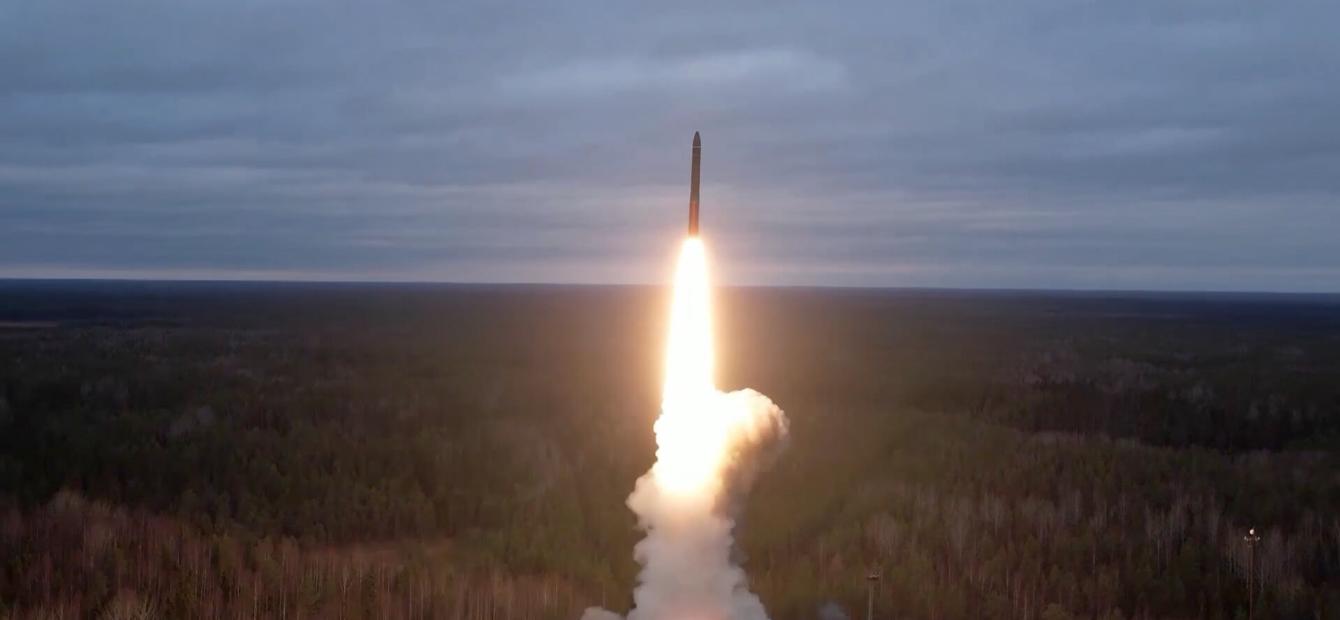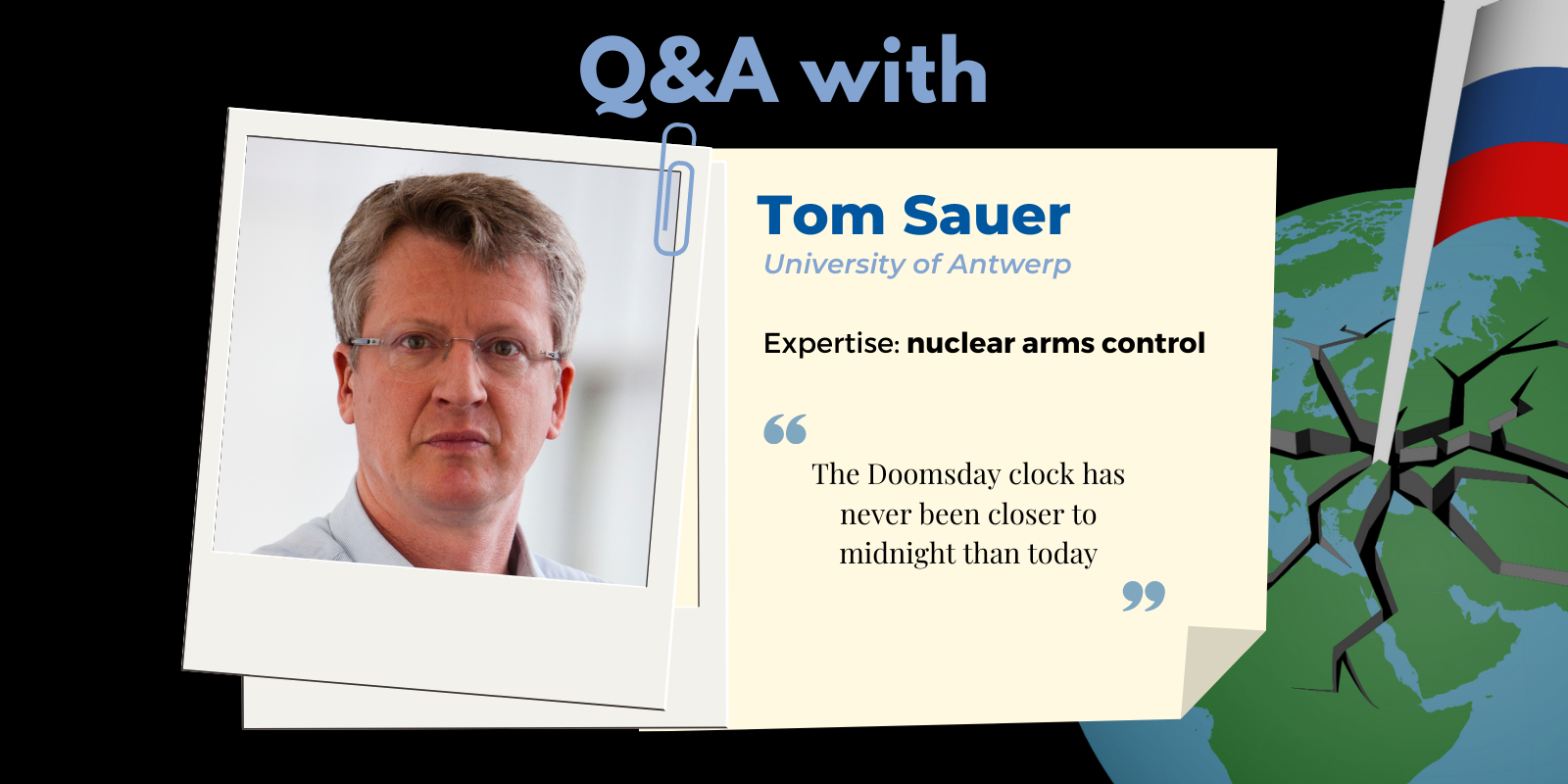
Q&A: Russia’s war renews great power nuclear rivalry
Russia’s war on Ukraine sends shockwaves across Europe and the wider world. This Clingendael Spectator Q&A series explores the wider geopolitical consequences with key analysts from across the globe. In this eight and last episode, Tom Sauer (University of Antwerp) discusses the risk of the use of nuclear weapons.

Question 1: UN Secretary-General António Guterres has observed that – due to Russia’s war on Ukraine – the “prospect of nuclear conflict, once unthinkable, is now back within the realm of possibility”.1 Is this dangerously alarmist, or do you agree?
Guterres is certainly not dangerously alarmist. For the first time since the Cuban missile crisis (in 1962), the world faces the risk of a nuclear attack by one of the – or both – former superpowers that together possess 90 per cent of the 13,000 nuclear weapons existing worldwide. The Doomsday clock has never been closer to midnight than today.
We have been told for decades that nuclear weapons exist for ‘political’ – read defensive and therefore deterrent – purposes, not for being used. ‘Nuclear weapons yield stability, security and peace’, it was said. But we now see that the critics of nuclear weapons have been right all along: behind a wall of 6,000 nuclear weapons, Russia has cowardly attacked a non-nuclear-weapon state.
So, this large-scale and brutal (and up to now conventional) war does not bring stability, security and peace at all. Since the beginning of the war in Ukraine, Vladimir Putin and Dmitry Medvedev have implicitly threatened to use nuclear weapons at least four times. Putin has also asked the Russian military to increase the nuclear alert-levels.
Much is at stake for the Kremlin; Russia may indeed use a tactical nuclear weapon on Ukraine to stop the West escalating the war with the delivery of heavier weapon systems, especially if Putin is on the losing side. Even though it is uncertain whether this will happen, discarding this scenario as bluff would be extremely dangerous and irresponsible.
Question 2: The Russia-Ukraine war has seen several battles near operating nuclear power stations, most notably the Zaporizhzhia Nuclear Power Plant. How do you assess the threat of a nuclear calamity, and the role of the International Atomic Energy Agency (IAEA) in managing this crisis?
This is the first time in world history that nuclear reactors are being attacked in a war, which is of course very dangerous. In the fog of war, one of the reactors – or other sensitive facilities (like the pools where the used nuclear fuel rods are stored) – on the site of the Zaporizhzhia Nuclear Power Plant could be hit, even if not on purpose. In times of war, incidents happen – like the missile that landed on Polish territory in November 2022.
In the worst-case, an accident the size of Chernobyl and Fukushima happens – the consequences of which depend substantially on the weather circumstances, especially the wind direction. Radio-activity may spread beyond local cities to either Eastern and Western Europe, to Northern Europe, or even to Russia. The IAEA has tried to manage this crisis, but depends on Russia’s cooperation.
Question 3: What will be the impact of the war in Ukraine on Russia’s and the United States’ nuclear strategy? Has the war strengthened or undermined the concept of nuclear deterrence?
Referring to Russia’s war on Ukraine, both advocates and opponents of nuclear deterrence pick and choose arguments that prove their point. Advocates of nuclear deterrence point to the fact that a non-nuclear-weapon state has been attacked by a nuclear weapon state. ‘Had Ukraine kept the nuclear weapons it inherited from the USSR or had built their own, this war would not have happened’, they say.
Opponents nuance this stance by pointing out that nuclear-weapon states have also been attacked in the past, both by non-nuclear-weapon states (for example, Egypt and Syria against Israel) and nuclear-weapon states (for instance, Pakistan against India). In their view, these examples show that nuclear deterrence did not always work, and that it is not a panacea for world peace.
Intellectually, the most honest conclusion is that we simply do not know whether nuclear deterrence prevents conflict. The world may also have been ‘just’ lucky that nuclear weapons have not been used since 1945, as former US Secretary of Defence Robert McNamara stated. If this is true, the question arises how many times the world needs to be ‘lucky’ (including in this war), given that one large-scale nuclear war could mean the end of civilisation.
Question 4: Will Russia’s war on Ukraine weaken the Treaty on the Non-Proliferation of Nuclear Weapons (NPT), and spur nuclear proliferation around the globe?
If nuclear weapons (even a limited number) will be used in this war, the pressure to ban nuclear weapons – as article 6 of the NPT prescribes – is likely to prevail, especially following the entry into force of the Treaty on the Prohibition of Nuclear Weapons (TPNW) – signed by 122 states – in January 2021.2 Less, and someday maybe no, states may end up possessing nuclear weapons.
If nuclear weapons will not be used in this war, it can go both ways. This depends on whether advocates or opponents of nuclear weapons prevail in countries like Iran, Saudi Arabia, Egypt, Turkey, Brazil, South Korea and Japan. However, whether these states will go nuclear in the future will probably be determined more by regional circumstances than the outcome of the war in Ukraine.
That being said, the war already made one non-proliferation victim: the NPT Review Conference in which a consensus could not be reached due to a veto by Russia in August 2022. For the first time ever, two NPT Review Conferences in a row – in 2015 and in 2022 – failed to adopt a consensus document, a development that not bodes well for the future of the NPT.
Question 5: Is there any prospect for nuclear arms control between the US and Russia? Or do you foresee a future of escalating great power nuclear rivalry?
Nuclear arms control has been in crisis since the adoption of the New Strategic Arms Reduction Treaty (New START)3 in 2010, and arguably already since the mid-1990s. Prospects for a follow-up treaty of New START – the only remaining bilateral arms control treaty thanks to the extension by Joe Biden and Putin in 2021 – before it expires in 2026, are extremely bleak because of the war in Ukraine. New START may even collapse before the end of the war as both parties are currently accusing each other of not being in compliance.
Only after the war – whenever that will be – opportunities for a (literal) new start will exist. Nuclear arms control may even be a useful instrument for improving the overall political relationship between the US and Russia. But in the end, bilateral arms control will need to become trilateral as China is building up, and later on multilateral, as demanded by the NPT.
If nuclear weapons are used on a very limited scale during this war, it may even speed up the process of disarmament, as stated above. The most likely scenario, however, is that nuclear weapons will not be used, that not much will change, and that we will stumble into great power nuclear rivalry (including China) and a possible new nuclear arms race.
- 1António Guterres, ‘Secretary-General's opening remarks to the press on the war in Ukraine’, 14 March 2022.
- 2United Nations, ‘Treaty on the Prohibition of Nuclear Weapons’.
- 3Treaty between the United States and Russia on Measures for the Further Reduction and Limitation of Strategic Offensive Arms.








1 Comments
Load comments
Will nuclear arms become redundant?
Q: Has Russia, behind a wall of 6,000 nuclear weapons, cowardly attacked a non-nuclear-weapon state?
A: To quote American realist political scientist John Mearsheimer: by expanding Nato eastwards and inviting Ukraine to join, the West created an intolerable situation for Vladimir Putin, which would inevitably result in Russia taking action.
Q: Does the IAEA depend on Russia’s cooperation to manage the risk of the Zaporizhzhia Nuclear Power Plant being hit?
A: No. With the plant in Russian hands and a team of IAEA-experts deployed there, it is the Ukrainian side that is shelling de plant.
Q: Will the question whether countries like Iran, Saudi Arabia, Egypt, Turkey, Brazil, South Korea and Japan go nuclear be determined more by regional circumstances than the outcome of the war in Ukraine?
A: At best partly. States seek nuclear deterrence capability because of national security concerns, US threats in particular.
Q: Could mutual nuclear arms control be a useful instrument for improving the overall political relationship between the US and Russia?
A: Unlikely. Washingston's bellicosity towards Russia is bipartisan and motivated by neocon regime change and break-up objectives for the Russian Federation.
Finally, for the record: Russia is currently reformulating its nuclear doctrine. 'Preventive' tactical nuclear strikes could be considered, by analogy with US nuclear doctrine. In addition, if Kiev deploys Western long-range missiles against Crimea and/or Russian territory, Moscow will drop hypersonic missiles on US military installations in Europe and the US. These missiles are immune to air defences and, merely because of their mach 8-10 speed, have a devastating impact even without a conventional or nuclear payload.
With the atomic bomb dropped on Hiroshima being a far more powerful weapon of mass destruction with wide destructive power, overwhelmingly killing civilians and fallout as an aftereffect, 'clean' payloadless hypersonic missiles can be aimed with an accuracy of one metre at individual military targets such as weapons depots and aircraft carriers. Having hypersonic missiles in their arsenal, states may consider their nuclear weapons redundant, a boon to the process of nuclear disarmament.
Add new comment